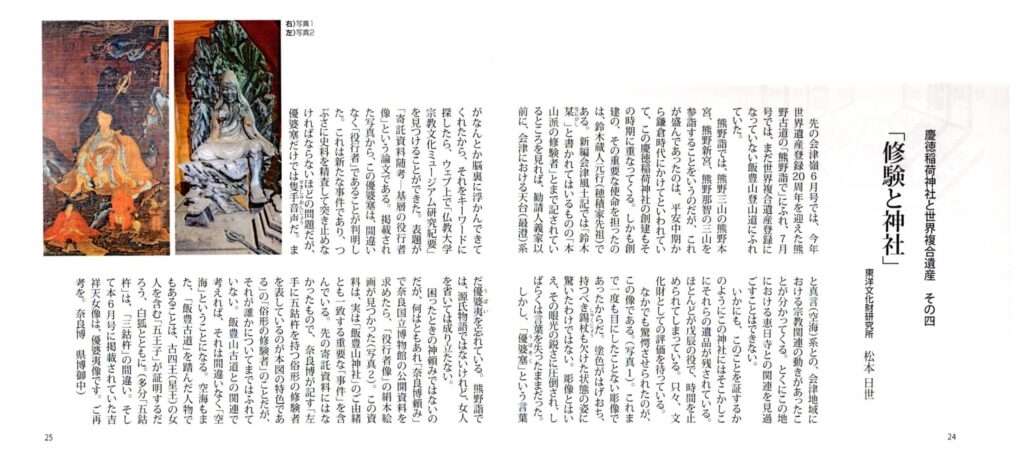Ascetic Practices and Shrines

Keitoku Inari Shrine and World Heritage Site 4
In the June issue of Aizumine, we mentioned the “Kumano Pilgrimage” of the Kumano Kodo, which celebrated its 20th anniversary of being registered as a World Heritage Site this year, and in the July issue, we mentioned the Iide Mountain Trail, which has not yet been registered as a World Heritage Site.
The Kumano Pilgrimage refers to visiting the three Kumano shrines of Kumano Hongu, Kumano Shingu, and Kumano Nachi, which is said to have been popular from the mid-Heian period to the Kamakura period, and the founding of this Keitoku Inari Shrine also coincides with this period.
Moreover, the person who took on the important mission of founding the shrine was Suzuki Kurodo Motoyuki (the ancestor of the Hozumi family).
Although the new edition of Aizu Fudoki refers to “Suzuki-san-sama (someone),” it is also written as “a mountain ascetic of the Honzan sect,” which shows that there was a religious movement in the Aizu region between the Tendai (Saicho) sect and the Shingon (Kukai) sect before the initiation of the shrine Yoshiie. In particular, the connection with Keiji Temple in this area cannot be overlooked.
As if to prove this, relics of this kind are left here and there in this shrine. Most of them have been frozen in time by the Boshin War. They are simply waiting to be evaluated as cultural assets.
The most surprising of all was this statue (Photo 1). It was a statue I had never seen before. I was not surprised by its state, with the paint peeling and the shakujo (scepter) missing. Even though it was a statue, I was overwhelmed by the sharpness of its gaze, and was left speechless for a while.
However, the word “upasaka” somehow came to mind, so I searched for it using that as a keyword, and found the “Bulletin of Research at the Buddhist University Museum of Religious Culture” on the web. The article was titled “A Study of Deposited Materials – A Basic “Statue” of En no Gyoja.” From the published photo, it became clear that this upasaka was definitely “En no Gyoja.” This is a new incident, and it is a problem that requires a detailed investigation of historical materials, but
The upasaka alone is only one-handed. They have still forgotten about the upasaku. The Kumano pilgrimage is not like the Tale of Genji, but it would not work if women were omitted.
It is not something to pray to when you are in trouble, but I turned to the Nara Museum anyway to look for public materials at the Nara National Museum, and found a silk painting of the “Portrait of En no Gyoja” (Photo 2). This material actually contains an important “incident” that coincides with the history of “Iideyama Shrine”. It was not included in the previously deposited materials, and the Nara Museum writes that “the distinctive feature of this painting is the depiction of a common-looking ascetic with a five-pronged vajra in his left hand,” referring to the “common-looking ascetic,” but does not go so far as to say who it is. Considering the connection with the Iideyama Old Road, it is definitely “Kukai.” The fact that Kukai also walked the “Iide Old Road” is evidenced by the “Five Princes,” including a woman from the Four Ancient Kings (Star Kings), along with the white fox. (Probably “Five Vajra” is a mistake for “Three-pronged Vajra.” And the statue of Kisshoten featured in this June issue is an Upahi statue. Please reconsider. Nara National Museum, Prefectural Museum)
